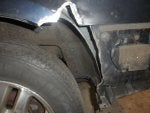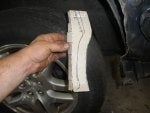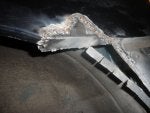My '99 Outback has some rust on the rear panel. I spent a good hour and a half using a grinder attachment (on a Dremel) to blow away all the surface rust, rip through any spots rusted through, and get down to the bare metal. The reality is that there is probably still some rust that I just didn't get. In fact, between the panels there is a bit of surface rust I cannot get to but I have tried to just punch out the metal curves in on the top panel. This way any rust on that is just gone and drops to the ground.
I was wondering if I could do the following:
1. Use rustoleum auto primer as a rust inhibitor on the entire surface area that I have sanded down to the bare metal. Here I'm trying to get the rust inhibitor on the metal to slow down the rust spread. Would a Loctite or this "POR-15" maybe work better?
2. Use bondo to patch up the holes.
3. Use a regular primer (likely an epoxy)
4. Spray a Duplicolor Perfect match auto paint - acrylic lacquer
5. Spray a Duplicolor protective clear coat finish
Are there major holes in this plan? My goal isn't to get a show room finish.. I would just really like this car to last for 5 more years on the body - I live in Wisconsin so that's tough.
Let's just assume I'm not cutting out the area and welding in a new piece. Any input is really appreciated, thanks.
I was wondering if I could do the following:
1. Use rustoleum auto primer as a rust inhibitor on the entire surface area that I have sanded down to the bare metal. Here I'm trying to get the rust inhibitor on the metal to slow down the rust spread. Would a Loctite or this "POR-15" maybe work better?
2. Use bondo to patch up the holes.
3. Use a regular primer (likely an epoxy)
4. Spray a Duplicolor Perfect match auto paint - acrylic lacquer
5. Spray a Duplicolor protective clear coat finish
Are there major holes in this plan? My goal isn't to get a show room finish.. I would just really like this car to last for 5 more years on the body - I live in Wisconsin so that's tough.
Let's just assume I'm not cutting out the area and welding in a new piece. Any input is really appreciated, thanks.














